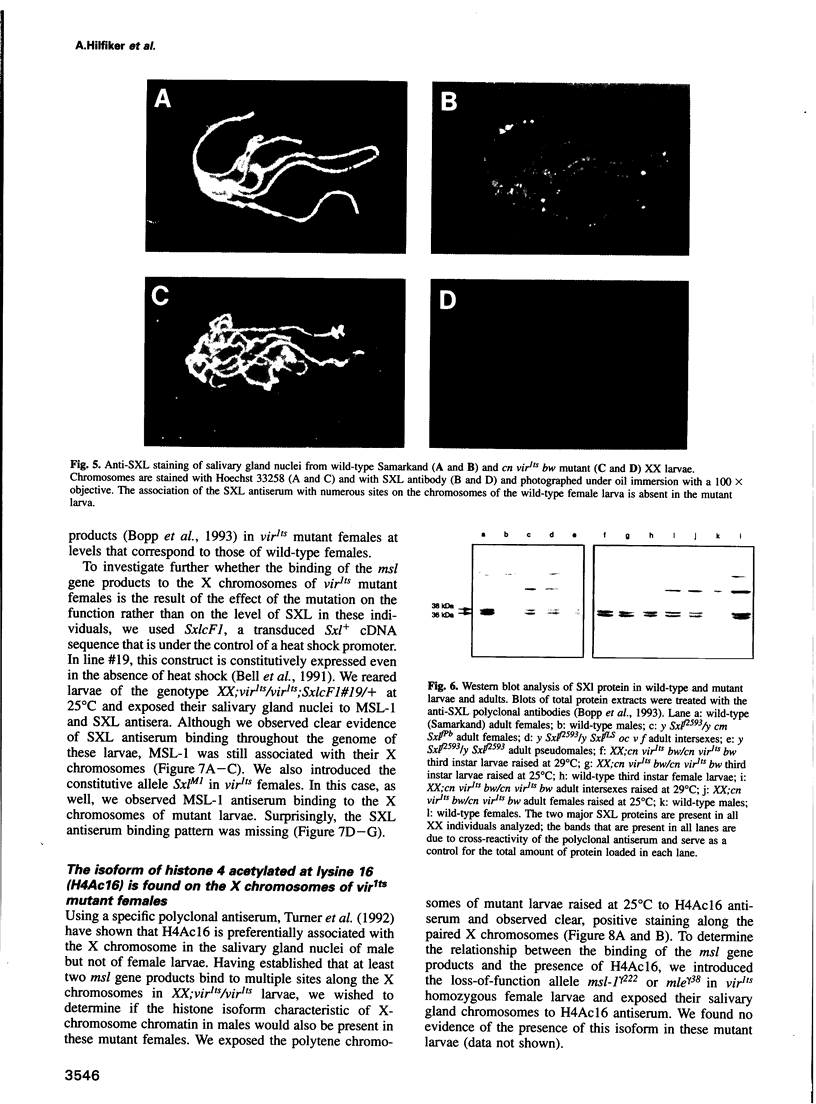Abstract
In Drosophila, dosage compensation, i.e. the equalization of levels of X-linked gene products in the two sexes, is achieved by the hypertranscription of most X-linked genes in males relative to females. The products of at least four genes, collectively termed male-specific lethal (msl) genes, are required for this process and, at least in the case of three of them, mediate this function through an association with the X chromosome in males. We have studied some of the parameters that affect the association of the msl-1 gene product and found that its presence is dependent on the wild-type function of the other three genes, leading to the conclusion that these gene products contribute to the formation of a multi-subunit complex. Furthermore, the X-chromosomal association of the msl-1 and mle gene products is negatively correlated with the level of function of the master regulatory gene Sxl and can assume either a mosaic or a uniform distribution in the tissues of mutant XX individuals. Surprisingly, we also found that the association of these two msl gene products with the two X chromosomes in females of certain mutant genotypes does not result in the hypertranscription of X-linked genes or in any apparent reduction in viability.
Full text
PDF








Images in this article
Selected References
These references are in PubMed. This may not be the complete list of references from this article.
- Bell L. R., Horabin J. I., Schedl P., Cline T. W. Positive autoregulation of sex-lethal by alternative splicing maintains the female determined state in Drosophila. Cell. 1991 Apr 19;65(2):229–239. doi: 10.1016/0092-8674(91)90157-t. [DOI] [PubMed] [Google Scholar]
- Belote J. M., Lucchesi J. C. Control of X chromosome transcription by the maleless gene in Drosophila. Nature. 1980 Jun 19;285(5766):573–575. doi: 10.1038/285573a0. [DOI] [PubMed] [Google Scholar]
- Bernstein M., Cline T. W. Differential effects of Sex-lethal mutations on dosage compensation early in Drosophila development. Genetics. 1994 Mar;136(3):1051–1061. doi: 10.1093/genetics/136.3.1051. [DOI] [PMC free article] [PubMed] [Google Scholar]
- Bone J. R., Lavender J., Richman R., Palmer M. J., Turner B. M., Kuroda M. I. Acetylated histone H4 on the male X chromosome is associated with dosage compensation in Drosophila. Genes Dev. 1994 Jan;8(1):96–104. doi: 10.1101/gad.8.1.96. [DOI] [PubMed] [Google Scholar]
- Bopp D., Bell L. R., Cline T. W., Schedl P. Developmental distribution of female-specific Sex-lethal proteins in Drosophila melanogaster. Genes Dev. 1991 Mar;5(3):403–415. doi: 10.1101/gad.5.3.403. [DOI] [PubMed] [Google Scholar]
- Bopp D., Horabin J. I., Lersch R. A., Cline T. W., Schedl P. Expression of the Sex-lethal gene is controlled at multiple levels during Drosophila oogenesis. Development. 1993 Jul;118(3):797–812. doi: 10.1242/dev.118.3.797. [DOI] [PubMed] [Google Scholar]
- Cline T. W. Two closely linked mutations in Drosophila melanogaster that are lethal to opposite sexes and interact with daughterless. Genetics. 1978 Dec;90(4):683–698. doi: 10.1093/genetics/90.4.683. [DOI] [PMC free article] [PubMed] [Google Scholar]
- Gorman M., Kuroda M. I., Baker B. S. Regulation of the sex-specific binding of the maleless dosage compensation protein to the male X chromosome in Drosophila. Cell. 1993 Jan 15;72(1):39–49. doi: 10.1016/0092-8674(93)90048-u. [DOI] [PubMed] [Google Scholar]
- Granadino B., Campuzano S., Sánchez L. The Drosophila melanogaster fl(2)d gene is needed for the female-specific splicing of Sex-lethal RNA. EMBO J. 1990 Aug;9(8):2597–2602. doi: 10.1002/j.1460-2075.1990.tb07441.x. [DOI] [PMC free article] [PubMed] [Google Scholar]
- Granadino B., San Juán A., Santamaria P., Sánchez L. Evidence of a dual function in fl(2)d, a gene needed for Sex-lethal expression in Drosophila melanogaster. Genetics. 1992 Mar;130(3):597–612. doi: 10.1093/genetics/130.3.597. [DOI] [PMC free article] [PubMed] [Google Scholar]
- Kuroda M. I., Kernan M. J., Kreber R., Ganetzky B., Baker B. S. The maleless protein associates with the X chromosome to regulate dosage compensation in Drosophila. Cell. 1991 Sep 6;66(5):935–947. doi: 10.1016/0092-8674(91)90439-6. [DOI] [PubMed] [Google Scholar]
- Lucchesi J. C., Skripsky T. The link between dosage compensation and sex differentiation in Drosophila melanogaster. Chromosoma. 1981;82(2):217–227. doi: 10.1007/BF00286106. [DOI] [PubMed] [Google Scholar]
- Mukherjee A. S., Beermann W. Synthesis of ribonucleic acid by the X-chromosomes of Drosophila melanogaster and the problem of dosage compensation. Nature. 1965 Aug 14;207(998):785–786. doi: 10.1038/207785a0. [DOI] [PubMed] [Google Scholar]
- Palmer M. J., Mergner V. A., Richman R., Manning J. E., Kuroda M. I., Lucchesi J. C. The male-specific lethal-one (msl-1) gene of Drosophila melanogaster encodes a novel protein that associates with the X chromosome in males. Genetics. 1993 Jun;134(2):545–557. doi: 10.1093/genetics/134.2.545. [DOI] [PMC free article] [PubMed] [Google Scholar]
- Salz H. K., Cline T. W., Schedl P. Functional changes associated with structural alterations induced by mobilization of a P element inserted in the Sex-lethal gene of Drosophila. Genetics. 1987 Oct;117(2):221–231. doi: 10.1093/genetics/117.2.221. [DOI] [PMC free article] [PubMed] [Google Scholar]
- Turner B. M., Birley A. J., Lavender J. Histone H4 isoforms acetylated at specific lysine residues define individual chromosomes and chromatin domains in Drosophila polytene nuclei. Cell. 1992 Apr 17;69(2):375–384. doi: 10.1016/0092-8674(92)90417-b. [DOI] [PubMed] [Google Scholar]










